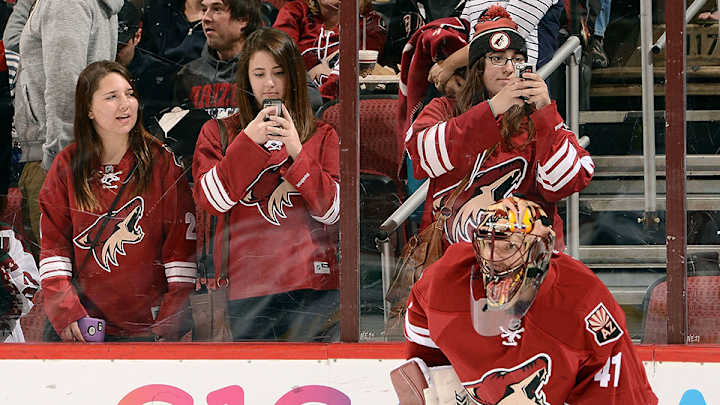Social media's changed how NHL fans watch the game

Social media has without doubt created a more active and engaged hockey fan who has never had an easier time following their favorite sport. During live broadcasts or at the arena fans constantly check Twitter, post and chat about the game they are watching, and simultaneously keep up with the latest news and trends. Research has found thathockey fans are among the most tech-savvy in sports. Look no further than the NHL’s wide array of bloggers, some of whom led the advanced statistics charge, a movement that grew with the use of social media.
Given hockey's status as the four or fifth banana among the major pro sports in the U.S., the NHL wisely realized the value of digital media as another way to promote itself and serve its fans who eagerly embraced the ability to voice their opinions in forums and social media platforms on a global scale. This phenomenon isn’t simply called “checking your phone while you are watching a game.” It’s known as “Second Screen Consumption.”
Dallas Stars score big with Jumbotron jokes that go viral
According to an article in the Journal of Broadcasting and Electronic Media by Jaclyn Cameron and Nick Geidner, the original idea of the second screen involved the use of mobile/digital devices during live broadcasts so viewers can engage in social discussions of issues related to the event. While watching in real time, the audience is presented with an additional broader, dynamic and instantaneous experience.
”Sporting events are one of the rare programs that have defeated the DVR,” says Andi Perelman, Manager of New Media for the Pittsburgh Penguins. “Fans want to discuss in real time. All the stats and information you could ever want is right there at your fingertips, and it’s other fans, friends and trusted teams and reporters that are providing it.
“It creates a giant community of fans that can watch and share together. It's like being at a sports bar while you are at home on your couch. You are never watching your team alone.”
Not limited to hockey, Second Screen Consumption has broadened access to the entire sports and entertainment world. Twitter specifically has given fans an unprecedented opportunity to feel included and engaged.
• New Kessel Klassic: Twitter hails Phil's first Penguins photo
Like their counterparts in other sports and leagues, NHL teams have become social media content creators by using Twitter, Facebook and related platforms to interact with and update fans. According to Rob Mixer, Manager of Digital & Social Media for the Columbus Blue Jackets, this content must complement Second Screen Consumption.
“If you’re not producing content to capture attention on the second screen, you’re doing it wrong” he says. “In my opinion, your in-game content should be optimized for mobile consumption.”
NHL teams such as the Los Angeles Kings are considered trailblazers in social media activities, innovation and engagement. They’ve adopted a creative and effective way of maximizing their efforts by creating fresh, compelling and engaging content with a distinctive tone and personality for their fans.
The Kings’ social media content has been described as creative, snarky, irreverent, entertaining, edgy, humorous, sarcastic and controversial. One of their best examples is a tweet from after the Kings defeated the top-seeded Vancouver Canucks in the 2012 Stanley Cup playoffs:
To everyone in Canada outside of BC, you're welcome.
— LA Kings (@LAKings) April 12, 2012
The Kings often veer into popular culture. During a playoff series against the New Jersey Devils, their Twitter account asked, “Aside from fist pumping, what else is there do in NJ?,” a reference to the MTV reality show Jersey Shore. They also posted a photo after the New York Rangers scored on the Kings, referencing the movie Gangs of New York:
bad guys score. pic.twitter.com/pMwm8gB3lR
— LA Kings (@LAKings) June 8, 2014
Players, too, have been doing their part to interact with fans. Florida Panthers goalie Roberto Luongo has attracted 563,000 followers with his often funny posts.
• Former NHL defenseman Ryan Whitney hilariously live-tweets Oscars
“It is essential to create fun and interactive social media content for hockey fans,” Perelman says. “Social media provides the opportunity to provide value to fans all the time. If fans are active on social 24/7 asking questions and discussing the team, shouldn’t we be there to converse? Of course we should.”
Creating social media content that makes fans want to come back for more only leads to loyalty to the NHL brand.
“We wanted to talk with our fans and not at them,” Mixer says.
